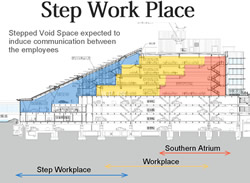Last Uploaded: February, April, 2011
Nissan Advanced Technology Center
Special Features
| Q-1 Indoor Environment |
- Use of natural light through top lights on the north side
- Air conditioning with floor diffusers
- Louver decks also used for maintenance access
|
| Q-2 Quality of Service |
- Large open office with floor plates exceeding 100x70 (m)
- Exposed ceiling
- Ceiling height exceeding 3.0m (max. 3.8m)
- See-through utility room for air conditioning system
- Seismic-isolated structure
|
| Q-3 Outdoor Environment on Site |
- Rooftop greenery
- Greening of concrete embankments
- Green cube brings nature into workplace
- Plant design in harmony with natural vegetation
- Transplanting existing mature trees
|
| LR-1 Energy |
- PAL value at 208.7MJ/m2/year with Low-E glasses
- Air conditioning with floor diffusers
- Natural ventilation and outdoor air cooling systems
- Outside air intake via cool/heat trench
- Natural ventilation with solar chimney
- Daylight control system
- BEMS
|
| LR-2 Resources and Materials |
- Kitchen water recycled for washroom cleaning
- Rainwater recycling
- Recycling of existing concrete debris for green embankments
|
| LR-3 Off-site Environment |
- High-efficiency heat source operation with energy plant
- Reduced CO2 during operation due to natural energy utilization measures such as outdoor air cooling and use of natural light
- Rainwater infiltration facility
- Reduced infrastructure loads through kitchen water reprocessing
- Processing facility for organic kitchen waste
|
Other Features
| The building was certified as the highest CASBEE-S ranking. [Certification #: IBEC-C0025-NC(c) |
These cases are described based on assessment results obtained using
CASBEE.
CASBEE is a method for rating the environmental performance of buildings using
Building Environmental Efficiency (BEE) as an indicator, which is based on the results of
separate scores obtained for Q-1~Q-3 (Quality) and LR-1~LR-3 (Load Reduction).













 Next Building
Next Building















 | Copyright © 2008 Institute for Building Environment and Energy Conservation, All Rights Reserved.
| Copyright © 2008 Institute for Building Environment and Energy Conservation, All Rights Reserved.